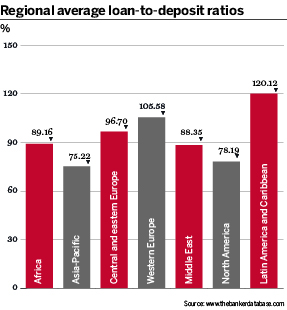Loan-to-deposit (LTD) ratios, a common yardstick for measuring bank liquidity, have seen a mixed performance in the 2018 Top 1000 World Banks rankings. The aim is to find a happy medium between a high LTD ratio, which suggests a bank may struggle to cover unforeseen needs, and a low ratio, which indicates it may not be making the most of its deposit base.
Global regulators have been encouraging banks to hold more deposits relative to loans, aiming to make banks more resilient. They tend to favour more ‘sticky’ retail deposits over short-term funding such as money markets.
Increases in interest rates usually encourage account holders to save, but very low interest rates in many countries have made it much more challenging for banks to attract savings. Traditionally, regulators have estimated that an LTD ratio of 80% to 90% is prudent.
The biggest regional rise in LTD ratios in the 2018 ranking was seen in Latin America and the Caribbean, where the aggregate rose by more than 34.3 percentage points to 120.12%. Western Europe dropped once more – by 3.03 percentage points to 105.58% – and is the region with the second highest LTD ratio, displacing central and eastern Europe at 96.7%. Meanwhile, Africa saw a rise of 9.8 percentage points to 89.16%.
Asia-Pacific, the region with the lowest LTD ratio, saw a modest rise of 2.04 percentage points to 75.22% and North America saw an even smaller rise of 0.19 percentage points to 78.19%. The Middle East, meanwhile, had an LTD ratio of 88.35%.
In terms of LTD distribution ratios, there was little change in the overall figures. Well over one-third of banks (39.6%) reside within the 75% to 100% bracket and just under one-third (30.41%) are in the 0% to 75% classification, with the remainder scoring LTD distribution ratios above 100%.
Despite little overall change, there is some movement within individual brackets, particularly that for 75% to 100%. The 0% to 75% bracket saw a 1.15 percentage points fall to 30.41, the 75% to 100% bracket saw an increase of 2.51 percentage points to 39.60%, the 100% to 125% bracket saw a 0.66 percentage points fall and the 125%-plus bracket registered a 0.7 percentage points fall at 11.08.
Even though the overall numbers only show modest changes, there was much more movement within some individual regions. Africa saw rises on the outliers at the expense of the 75% to 100% bracket. In the 0% to 75% bracket, the continent saw an 8.33 percentage points rise to 33.33%, the 75% to 100% bracket saw an 17.86 percentage points decrease to 50%, in the 100% to 125% bracket it went up 6.43 percentage points to 10% and the 125%-plus bracket it rose 3.1 percentage points to 6.67%.
There were some notable individual movements across some other regions. In the 0% to 75% bracket, central and eastern Europe saw a rise of 7.48 percentage points to 60.61%. Also, in the 0% to 75% bracket, Latin America and the Caribbean had a 6.75 percentage points increase to 24.56%.
The Middle East saw significant moves in two brackets. In the 0% to 75% bracket the region saw a 8.27 percentage points rise to 50.62% and in the 100% to 125% bracket it fell 4.54 percentage points to 28.40%. North America and western Europe saw relatively little movement between individual brackets.
Loan-to-deposit ratio distribution (% of banks in each bracket)
| Region | 0%-75% | 75%-100% | 100%-125% | >125% |
| Africa | 33.33 | 50.00 | 10.00 | 6.67 |
| Asia-Pacific | 49.32 | 39.02 | 8.13 | 3.53 |
| Central and Eastern Europe | 24.24 | 60.61 | 12.12 | 3.03 |
| Western Europe | 15.57 | 21.70 | 34.43 | 28.30 |
| Latin America and Caribbean | 26.31 | 24.56 | 22.81 | 26.32 |
| Middle East | 17.28 | 50.62 | 28.40 | 3.70 |
| North America | 16.57 | 56.57 | 20.00 | 6.86 |
| TOTAL | 30.41 | 39.60 | 18.91 | 11.08 |





